BENEFITS OF BUCKWHEAT
✓ Enriches the microbiota
✓ Helps with weight loss
✓ May improve diabetes
✓ Reduces cholesterol levels
✓ Supports cardiovascular health
What is buckwheat?
Buckwheat (Fagopyrum esculentum Moench) is the main representative of the Polygonaceae family. Also called “black wheat”, in reference to the color of the hull that surrounds its seeds, it is often considered a cereal.
However, like quinoa, amaranth or the chia, buckwheat is a pseudo-cereal: it is not part of the grasses but its seeds are consumed like cereals. The genus Fagopyrum includes two main buckwheat species: Fagopyrum esculentum or common buckwheat and Fagopyrum tataricum, Tartary buckwheat.
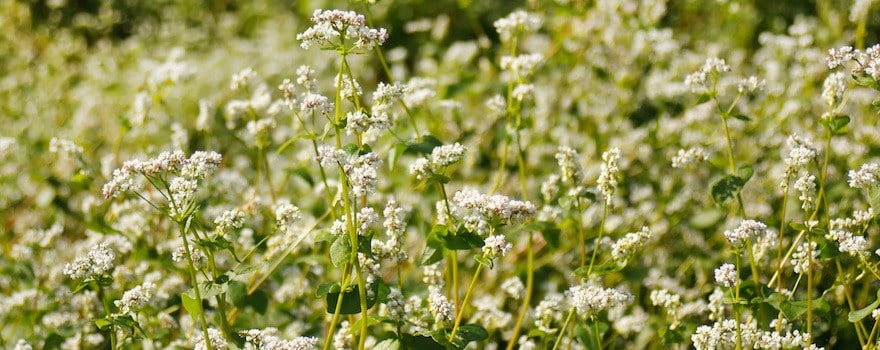
It can reach 70 cm in height. It has purple stems, heart-shaped leaves and produces pretty white clustered flowers. Cold-tolerant and suited to poor soils, it has long been appreciated for its ease of cultivation.
Native to Asia, it was first cultivated in Mongolia and China for its seeds intended for human and animal consumption. Although it nearly disappeared, it has returned to the spotlight today. It has the advantage of being gluten-free and is therefore ideal for people with celiac disease or gluten intolerance. It also contains many nutrients, including significant amounts of protein, fiber and magnesium.
Buckwheat seeds also uniquely contain all of the essential amino acids required by the human body.
This rich and varied composition provides many benefits to the body. Buckwheat is particularly useful for replacing animal proteins in a vegetarian or vegan diet. It also helps with weight loss, helps improve diabetes, enriches the microbiota, lowers cholesterol and supports cardiovascular health. Recent studies also show its anti-cancer potential.
Nutritional composition
- Acides aminés dont les 8 essentiels
- Vitamines : B1, B2, B3, B5, B6, B9, E
- Minéraux et oligo-éléments : sodium, potassium, calcium, fer, magnésium, phosphore, cuivre, manganèse, zinc
- Protéines
- Lipides
- Glucides
- Fibres
- Eau
- Polysaccharides : alginate, fucoïdane
- Flavonoïdes : rutine, quercétine, vitexine
- Acides phénoliques : acide caféique, acide férulique, acide hydrobenzoïque, acide coumarique
- Phytostérols
- Autres substances : D-chiro-Inositol, D-Fagomine
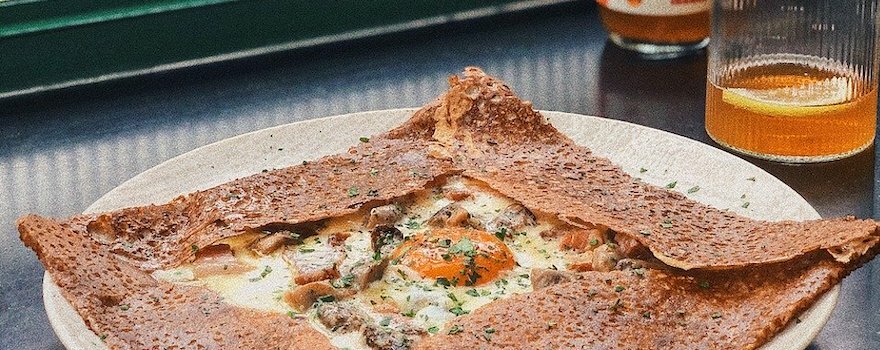
Benefits of buckwheat
♻️ Enriches the microbiota
Like carob, cacao or the pulp of baobab, buckwheat is among the prebiotic foods. Thus, it is beneficial for microbiota health (formerly called intestinal flora).
On the one hand, its consumption helps reduce populations of harmful bacteria in the gut. It notably decreases the presence of enterobacteria, which are responsible for intestinal disorders and severe diarrhea.
On the other hand, buckwheat promotes the growth of good bacteria such as lactobacilli and bifidobacteria. It increases, among others, the populations of Lactobacillus plantarum, Bifidobacterium spp and Bifidobacterium lactis, which are essential to microbiota balance.
This study from the University of Madrid (Spain), conducted on rats, shows the beneficial effects of buckwheat as a prebiotic food.
🏃🏻♂️ Helps with weight loss
Buckwheat is a valuable ally for losing weight. Thanks to its high fiber content, it promotes the feeling of fullness and limits cravings throughout the day.
100 g of buckwheat seeds contain about 10 g of dietary fiber, which is more than some cereals like barley or oats. They are mainly soluble fibers, such as pectin, which have the property of turning into a viscous gel on contact with water. Once in the stomach, these fibers swell and increase the feeling of fullness, reducing the desire to snack.
Moreover, they slow the absorption of fats and carbohydrates into the bloodstream in order to limit fat storage in the body. In this respect, it acts like other foods such as psyllium, chia seeds or the guar gum.
Buckwheat fibers also have the advantage of being very digestible and suitable for sluggish transit. They aid digestion and the passage of food through the intestinal tract, important factors for healthy weight loss and a flat stomach.
This study from the University of Ljubljana (Slovenia), conducted in healthy individuals, shows how buckwheat accelerates satiety.
🍭 May improve diabetes
Buckwheat fibers also have a beneficial effect on type 2 diabetes. They help normalize blood glucose levels (glycemia) and prevent insulin spikes after meals.
But, in addition to fiber, the seeds contain a natural compound quite rare in the diet : D-chiro-inositol (DCI). It is an insulin mediator that reduces insulin resistance. It also helps maintain blood sugar levels and accelerates glucose elimination.
Buckwheat also contains D-fagomine, a sugar that reduces fat accumulation and lessens insulin resistance. It also helps delay the onset of a pre-diabetic state during a high-fat diet.
Finally, it has the advantage of having a low glycemic index equal to 40, which is lower than that of wheat, rice, or rye.
This study from the University of Manitoba (Canada), conducted on rats, shows the effectiveness of D-chiro-Inositol in lowering blood glucose.
Another study from the Institute for Food and Nutrition Development in China, conducted in patients with type 2 diabetes, shows how buckwheat reduces insulin resistance and improves lipid profiles.
🍳 Reduces cholesterol levels
Because it contains a large amount of fiber, buckwheat fights hyperlipidemia which is characterized by a high cholesterol level. Its fiber notably limits cholesterol absorption and promotes its elimination when present in excess.
It increases HDL cholesterol (or “good cholesterol”) and decreases LDL cholesterol (or “bad cholesterol”). The cholesterol-lowering action of the fiber is complemented by certain amino acids found in buckwheat, such as arginine and carnitine.
Finally, it contains vitamin B3 (or niacin), which lowers blood cholesterol levels.
This study from Uppsala University (Sweden), conducted on women, explains how buckwheat lowers cholesterol levels.
❤️ Supports cardiovascular health
By reducing cholesterol levels, buckwheat contributes to cardiovascular health and reduces the risk of heart disease. It also contains various nutrients that are beneficial for the heart.
Its flavonoids, such as quercetin, protect blood vessels. They strengthen and improve arterial elasticity. Like the ginkgo biloba, buckwheat is also an excellent source of rutin that protects against clot formation.
Finally, magnesium and copper and the vitamin B6 help maintain good cardiovascular health and prevent certain disorders such as heart palpitations.
This study from Hebei United University (China), conducted on rats, shows how buckwheat rutin inhibits cardiomyocyte hypertrophy associated with heart failure.
🔬 Potentially anti-cancer
Various studies have shown buckwheat’s anti-cancer potential, notably against breast and colon cancer. Its effect is largely due to the fibers and proteins it contains.
On the one hand, it exerts anti-proliferative effects : it limits the development of cancer cells, preventing their migration and invasion within the body.
On the other hand, it induces apoptosis, that is programmed cell death. Cancer cells then trigger their self-destruction.
This study from Jiangnan University (China), conducted on a cancer cell line, demonstrates buckwheat’s various anti-cancer actions.
This other study from Kangwon National University (South Korea), also conducted on cancer cells, shows how buckwheat inhibits their development.
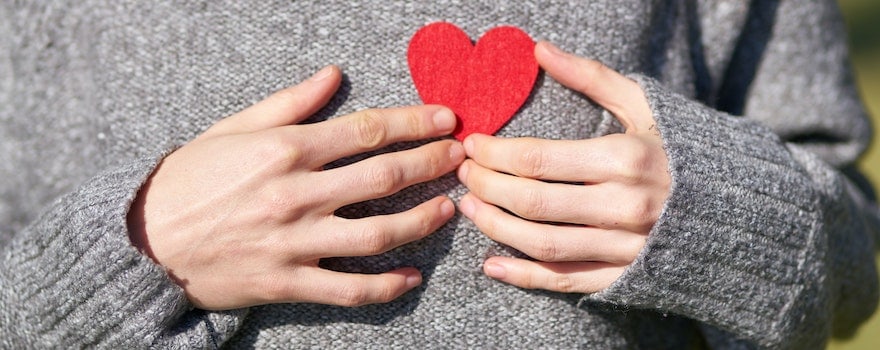
How to consume buckwheat?
Buckwheat seeds
Buckwheat seeds, whole or hulled (called “white buckwheat”), have a pronounced nutty taste. Versatile, they are ideal as a side for salads, meat dishes, vegetables, and fish. They are a great substitute for rice and pasta and can be enjoyed in many ways.
For example, you can cook buckwheat seeds risotto-style, add them to vegetarian dishes (veggie balls, falafels, patties…) or simply pan-fry them.
They also work well in sweet recipes: cookies, tarts, crumbles, porridges…
Buckwheat seeds tend to soften and absorb water when cooked for too long. It is important to rinse them and cook them over low heat in twice their volume of water for about 15 minutes. Then let them rest off the heat for 5 to 8 minutes. You will then get firm, crunchy buckwheat.
Toasted buckwheat seeds
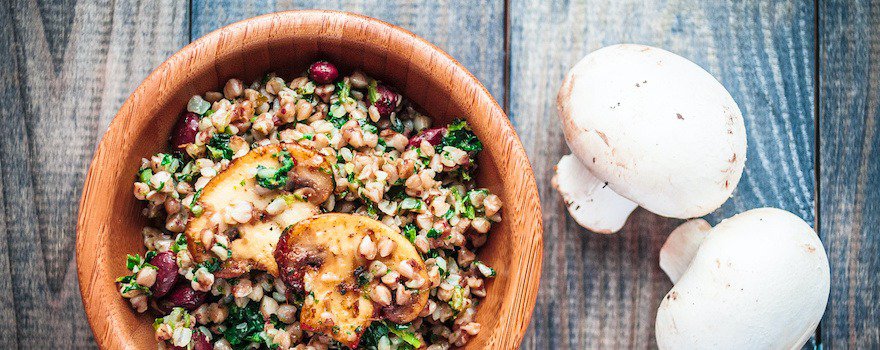
Hulled and roasted buckwheat seeds are called “kasha”. It is an Eastern European specialty with a toasted nutty flavor, often eaten as groats, in soups, stews, and porridges. Kasha offers a distinctive, more pronounced taste than regular buckwheat.
It can be bought or easily prepared at home. Simply toast the hulled buckwheat seeds in a pan, without any fat, until they turn golden brown.
Kasha is tender enough to be eaten raw. You can eat it as is or add it to your mueslis and cereal mixes. It can also be cooked in 1.5 times its volume of water in just 5 minutes.
Finally, kasha can be used to prepare a delicious Japanese infusion called “Sobacha”. The seeds are steeped for 5 minutes in boiling water. Use 4 g of seeds per 200-ml cup. You can flavor your Sobacha with green tea leaves, honey, or lucuma powder lucuma.
Buckwheat flakes
Buckwheat flakes are obtained by crushing the seeds and then undergoing a gentle steam cooking. Perfect for breakfast, they can also be added to creams, soups, galettes, cookies, yogurts, purées…
Added before the end of cooking, the flakes can be used to thicken homemade soups and veloutés.
Buckwheat flour
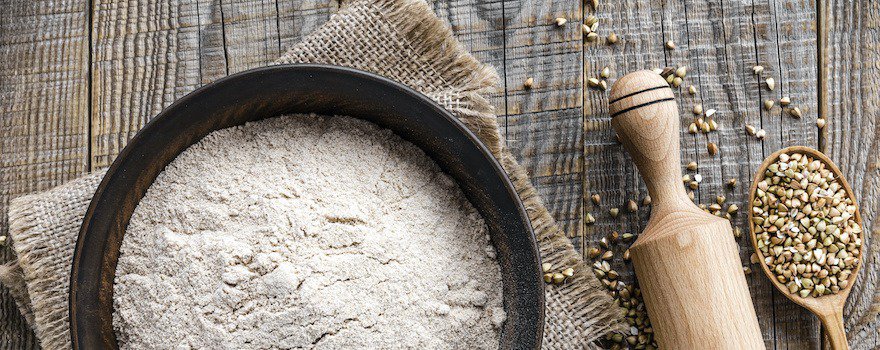
Because it has a rather bitter taste, buckwheat flour is often used in combination with other flours (except for Breton galettes). If you want to keep its “gluten-free” advantage, choose rice, quinoa, corn, or chestnut flour… which are also gluten-free. Buckwheat flour makes up 20 to 25% of the blend.
Buckwheat flour can be used to make breads, cakes, galettes, crepes… It is also included in the recipe for the famous Japanese Soba noodles.
Buckwheat sprouts
It is possible to buy or sprout hulled buckwheat seeds yourself. Germination is simple and quick (about 2 to 3 days). The seeds then have a very mild, neutral taste. Once rinsed, they can be eaten raw or steamed, added to a salad, a smoothie, or served with other sprouted seeds.
Consume sustainably: prioritize local, organic, and fair-trade buckwheat
✓ Even though China, Russia, Ukraine and Kazakhstan are currently the main producing countries, buckwheat has long been cultivated in France. Introduced in the 20th century, its cultivation covered about 300,000 hectares, a large part of which were located in Brittany. Unfortunately, like millet or spelt, buckwheat has gradually disappeared from our regions, replaced by rice and other cereals.
✓ Today, farmers are trying to revive buckwheat cultivation in Brittany. By buying buckwheat of French origin, you contribute to the development of this local crop. Also prefer products from organic farming.
✓ There are also fair-trade supply chains for buckwheat (including in France) that help support small-scale farming.
Dosage
There isn’t really a recommended dosage for buckwheat. It can replace the portion of starchy foods you are advised to consume each day.
- Graines de sarrasin : 50 g par personne
- Flocons de sarrasin : 100 à 200 g par jour
- Farine de sarrasin : 20 à 25% de la préparation
- Graines germées de sarrasin : 1 à 2 cuillères par personne, 2 à 3 fois par jour
Contraindications and side effects
Buckwheat consumption has certain contraindications :
- En raison d’une possible allergie croisée, les personnes allergiques au latex ou au riz doivent éviter d’en consommer
- Les personnes atteintes de troubles gastro-intestinaux, du syndrome du côlon irritable ou de la maladie de Crohn doivent en consommer avec modération.
Buckwheat consumption has few adverse effects. In case of excessive consumption, the following side effects may occur :
- Réaction allergique
- Flatulences
- Crampes intestinales
If you experience side effects, stop taking it and consult a doctor.
History, cultivation, and market of buckwheat
The earliest traces of agricultural cultivation of buckwheat date back to the mid-6th millennium, in northern China. It then spread south to the Himalayas, the Caucasus and Europe during the 14th century.
Buckwheat is not only notable for the nutritional richness and health benefits of its seeds; it is also valuable for biodiversity and for promoting more environmentally friendly agricultural practices.
On the one hand, buckwheat flowers are very nectar-rich. They attract many pollinating insects (bees, butterflies, bumblebees…) that feed on the nectar in July-August. Bees then produce buckwheat honey. Rare and sought-after, it offers pronounced aromas and a beautiful dark color.
In agriculture, it also has many uses. It is an excellent green manure which, in addition to smothering weeds, enriches the soil and improves soil structure. Moreover, buckwheat is not demanding in terms of fertilizers and generally has no pests or diseases. Its cultivation therefore helps limit the use of chemical products (fertilizers, pesticides, herbicides…). One more reason to revive this plant that has been forgotten for far too long.
Report prepared by Julia Perez
Sources and scientific studies
V Skrabanja, H G Liljeberg Elmståhl, I Kreft, I M Björck, 2001. Nutritional properties of starch in buckwheat products: studies in vitro and in vivo.
Julianne M Kawa, Carla G Taylor, Roman Przybylski, 2003. Buckwheat concentrate reduces serum glucose in streptozotocin-diabetic rats.
Ju Qiu, Yanping Liu, Yanfen Yue, Yuchang Qin, Zaigui Li, 2016. Dietary tartary buckwheat intake attenuates insulin resistance and improves lipid profiles in patients with type 2 diabetes: a randomized controlled trial.
G.Préstamoa, A.Pedrazuelab, E.Peñasa, M.A.Lasunciónc, G.Arroyob, 2003. Role of buckwheat diet on rats as prebiotic and healthy food.
Gunilla Wieslander, Nina Fabjan, Maja Vogrincic, Ivan Kreft, Christer Janson, Ulrike Spetz-Nyström, Blanka Vombergar, Christer Tagesson, Per Leanderson, Dan Norbäck, 2011. Eating buckwheat cookies is associated with the reduction in serum levels of myeloperoxidase and cholesterol: a double blind crossover study in day-care centre staffs.
Jin-xiu Chu, Guang-min Li, Xiu-juan Gao, Jian-xing Wang, and Shu-ying Hana, 2014. Buckwheat Rutin Inhibits AngII-induced Cardiomyocyte Hypertrophy via Blockade of CaN-dependent Signal Pathway.
Xiaona Guo, Kexue Zhu, Hui Zhang, and Huiyuan Yao, 2010. Anti-Tumor Activity of a Novel Protein Obtained from Tartary Buckwheat.
Soo-Hyun Kim, Cheng-Bi Cui, Il-Jun Kang, Sun Young Kim, Seung-Shi Ham, 2007. Cytotoxic effect of buckwheat (Fagopyrum esculentum Moench) hull against cancer cells.
Harriet V. Hunt, Xue Shang,corresponding, Martin K. Jones, 2018. Buckwheat: a crop from outside the major Chinese domestication centres? A review of the archaeobotanical, palynological and genetic evidence.



